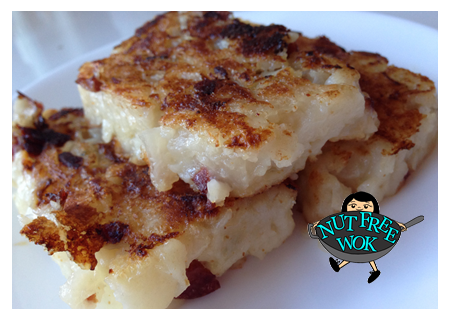
Turnip Cake is a steamed rice cake made with Chinese turnips, and flavored with minced Chinese sausages and/or dried shrimp and then pan-fried until crispy before serving for dim sum. Even though the total recipe time is nearly 9 hours, it takes about 4 hours to make the turnip cake, cool to room temperature and then refrigerate overnight. Pan-frying takes about another 30 minutes.
Disclaimer: Please check that all ingredients are suitable for your allergies and be sure to ask your medical care team regarding any allergy related questions (I do not share medical advice). As an Amazon Associate, I earn from qualifying purchases.
Do you want to read or print the recipe? Click on the Jump to Recipe link below. I recommend that you read the rest of the post to learn all of my cooking tips and food allergy mom experiences.
Jump to RecipeWe Love Dim Sum
My sons, who speak very little Cantonese, can definitely speak “Dim Sum” and ask for their favorite dishes. It seems like a distant memory but there was a time when our family could go to any Chinese Dim Sum restaurant and order anything we liked to eat prior to our food allergy diagnosis.
We no longer can go to any dim sum restaurant nor order anything we like and our favorite dim sum restaurant closed a few years ago. We miss them so much because the owner understood our concerns as he has some food restrictions as well. The waitstaff take my boys’ food allergies seriously and practically dote on them with their kindness and concern.
My sons zero in on the servers who bring around trays of turnip cake, also known as daikon cake or lo bak go in Cantonese, and we often have to order two dishes as one is not enough. So what’s a food allergy mother to do? Learn how to make turnip cake in between visits to the dim sum restaurant and call making dim sum a hobby!
What is turnip cake?
Turnip Cake is a steamed rice cake with pieces of daikon in them, sometimes with Chinese sausages, dried shrimp, preserved turnips, cilantro, and/or green onions. Then the cake is sliced and pan-fried until the outside is crispy but the inside is soft and hot. We know to watch for the server carrying a tray of pan-fried morsels of dim sum will have little plates containing 3 pieces of turnip cake.
Chinese New Year Significance
It is also a special Chinese New Year dish because the Chinese word for turnip, 菜頭 (Cài tóu) sounds like 好彩頭 (Hǎo cǎitóu), which means good luck, and part of the Chinese culture is to eat things which sounds prosperous and lucky.
Here are some of my Chinese dishes that are prepared during the Lunar New Year, you may enjoy some of these recipes and bless your family, you can see the complete collection of Best Lunar New Year Recipes For Your Celebrations:
- Chinese New Year Cake “Nian Gao” Recipe – a steamed glutinous rice cake dessert
- Rice Ovalettes with Pork and Vegetables Stir Fry Recipe (Chao Nian Gao) – a savory stir fry
- Chinese Style Steamed Fish & Chinese New Year – fresh steamed whole fish
- Delicious Red Bean Black Glutinous Rice Soup Recipe – this dessert soup is considered lucky
- Pan-Fried Pork and Shrimp Dumplings (Potstickers) – great appetizer
- Chinese Potstickers with Napa Cabbage Carrot Soup & Crazy Cuizine Review – use frozen potstickers to make soup
- Make Chicken Potstickers From Scratch Recipe – chicken potstickers
- Chinese Potstickers Recipe: Pork & Napa Cabbage – shrimp free potstickers
- Dim Sum: Turnip Cake – a savory steamed rice cake that is pan fried until crispy
- “Bok Cheet Gai” Slow Cooker Chinese White Cut Chicken – poach chicken in a slow cooker
- Easy & Low-Fat Chinese Salt and Pepper Garlic Shrimp Recipe – shrimp is an auspicious ingredient
- Happiness is a Shrimp Stir Fry with Spring Vegetables Recipe – a shrimp stir-fry
- Asian Chicken Lettuce Wraps are Easy to Make, Fun to Eat – lettuce represents abundance
- Stir Fried Iceberg Lettuce with Oyster Sauce – a simple stir-fry side dish
- Wagyu Sausage Lettuce Wrap – lettuce is symbolizes prosperity
- Make Beautiful Lettuce Cups for Lettuce Wraps
- Nut Free Chinese New Year Vegetable Stew “Jai” Recipe – a Cantonese vegetable stew with many auspicious ingredients
Preparation Tips
I don’t recall my mom ever making turnip cake so I looked up recipes in cookbooks and online to learn on my own. I like the clear instructions from Ellen Blonder’s Dim Sum: The Art of Chinese Tea Lunch but I discovered a few lo bak go making tips along the way which led to the recipe below.
- Select daikons about 1 1/2 inches in diameter. They are easier to grate and chop and have a milder flavor. The daikons should feel heavy for their size and feel firm.
- Grate and dice: Some recipes call for grated daikon which makes it easier to slice and handle the steamed turnip cake. Other recipes call for diced daikon which yields tasty morsels of turnip that fall out of a very soft rice cake. My happy medium is to dice half of the daikon and grate the other half as the texture and ease of handling is perfect.
- Use salt and chicken broth. My early tries at making lo bak go tasted strong and peppery, almost bitter. One of my mom’s friends, Auntie Bak Yu, suggested that I salt the prepped daikon and then squeeze out the liquid as the salt draws out some of the strong flavor. My mom suggested cooking in chicken broth rather than water.
- Add the rice batter when the daikon is hot.
- I have discovered that adding rice flour to cooled daikon and broth results in layered daikon cake where the daikon is on top and the rice flour is on the bottom.
- It is important to add the rice flour and water mixture to very hot daikon and broth mixture and stir until it looks like mashed potatoes.
- I have also discovered that adding rice flour directly into the hot daikon and broth results in lumpy daikon cake, so blending the flour with water is important.
Planning, Recipe Variations, and Storing Leftovers
- Allow 1 day lead time. This dish is relatively simple and easy, but it is a labor of love that takes 1 day lead time to prepare. For that reason, I double the recipe as it is not too much more trouble to double the ingredients and besides pan frying time, it doesn’t take too much extra time. I pan fry all of it in 3 batches using a 14 inch frying pan or I use 2 frying pans at the same time to save time.
- Pan-fry in batches all on the same day if serving a large group. If you are making this for your family, pan-fry 1-2 pieces per person over 3-4 days. You could pan fry in advance but it won’t be as crispy.
- Vegan option: One can make the turnip cake completely vegan by using vegetable broth and leaving out the shrimp and sausages and sautee the mix-in ingredients in a tiny bit of olive oil and the carrots, green onions, and cilantro will provide some nice color and textures.

Allergy Aware Turnip Cake Ingredients:
Rice flour: I have had the best results from using Erawan brand rice flour (in a red bag, the logo is a three headed elephant), it is a well-known brand mentioned in gluten free cookbooks and inexpensive to purchase from Asian markets (less than $2). I have used it for years but haven’t been able to verify that it is nut-free. However, I have been able to confirm that the Flying Horse brand (also in a red bag) is nut free. Also Koda Farms makes rice flour in a rice only facility but you may need to order by mail. I have also used Arrowhead Mills Brown Rice Flour after discussing with them at length about their allergen policy. No matter what brand you buy, be sure to buy “rice flour” not glutinous rice flour (usually in a green bag), which is made from sweet rice and will yield a different texture.
Shrimp allergy: Most restaurant prepared turnip cakes will contain dried shrimp but the beauty of making it yourself, is that you can omit the shrimp and substitute diced carrots if you want.
Soy and/or gluten allergy: Chinese sausages are typically marinated with soy sauce, use bacon instead. Substitute the soy sauce with tamari sauce or a Soy-Free Soy Sauce Recipe, Top 9 Allergen Free.
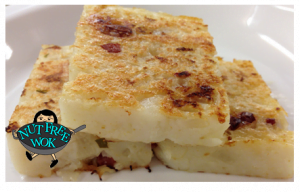
Turnip Cake, Nut Free Dim Sum Recipe
Ingredients
Daikon Mixture
- 2 daikons (medium) 1 1/2 inch diameters
- 1/2 teaspoon salt
- 4 cups chicken broth or vegetable broth
Sausages & Herbs
- 2 Chinese sausages “lap cheong” (optional or substitute bacon)
- 1/2 teaspoon olive oil or neutral oil
- 1/4 cup carrots, diced optional
- 2 tablespoons dried shrimp optional
- 2 stalks scalliions chopped (optional)
- 1/4 cup cilantro chopped (optional)
- 1 teaspoon soy sauce optional
- 1/4 teaspoon granulated sugar optional
Rice Batter
- 3 1/2 cups rice flour 1 pound bag
- 1/2 teaspoon salt
- 1 teaspoon sugar
- 2 cups water
- Oil as needed
Instructions
- Brush some oil on a 2 quart casserole that will fit inside a large stock pot (8 quarts or larger), set aside. Fill a large stock pot (8 quarts or larger) with 1 1/2 inches of water with a steamer rack and set on low heat until ready to steam.
Daikon
- Peel the daikons, hold them at the top and grate the bottom end into a bowl or a fine colander. Stop when the daikon starts to feels tough, dice the remaining daikon that is easy to cut.
- Salt with 1/2 teaspoon salt and set aside for 30 minutes.
- Squeeze some of the daikon liquid out and place in a medium sized pot (4 quarts). Add the broth to the pot, add a lid, and cook on medium heat. When the pot boils, lower the heat, and then simmer on low for 30-40 minutes, until the liquid is reduced and the daikon is tender.
Mix In
- While the daikon cooks, cut the Chinese lengthwise into quarters and dice, chop green onions, cilantro and carrots; rinse and soak dried shrimp in a tiny amount of water for 10 minutes and then coarsely chop.
- IF USING Chinese sausage or bacon, then render fat in a small frying pan on low heat, and when the sausage/bacon starts to sizzle, stir fry in the chopped carrots or dried shrimp for a few minutes.
- IF NOT USING Chinese sausages or bacon, then stir fry the desired mix-in ingredients (carrots, shrimp) in 1/2 teaspoon of oil for a few minutes.
- Season the mix in ingredients with 1 teaspoon of soy sauce and 1/4 teaspoon sugar, remove from heat and set aside.
Rice Batter
- Add rice flour, 1 teaspoon sugar, and 1/2 teaspoon salt into a medium bowl and stir in 2 cups of cold water until the batter is smooth and not lumpy.
Steam the Turnip Cake
- Check the water level of the stock pot and raise the temperature to medium high so that the water is bubbly and boiling.
- Increase the heat of the daikon and broth to a rolling boil, remove from heat and immediately pour in the rice flour batter and stir quickly.
- Add the mix-in ingredients and stir (the mixture should resemble mashed potatoes if 1) the daikon is boiling hot and 2) the broth is reduced)
- Transfer the daikon and rice flour mixture to the prepared casserole and steam for 60 minutes on medium high heat.
- Allow daikon cake to cool to room temperature in its container, then cover and refrigerate overnight.
Pan Fry
- Preheat a non-stick frying pan on medium heat (4-5 minutes)
- Turn the casserole upside down on a cutting board and give a few taps, the daikon cake should slide out. Cut the cake into quarters and cut each quarter into 1/2 inch thick slices.
- When a drop of water sizzes on the pan and feels hot, add 1/2 teaspoon of oil and swirl to coat pan. Add the turnip cake slices to the pan.
- Pan fry for 10-12 minutes until crispy and slightly browned, flip, and pan fry for another 10-12 minutes.
- Garnish with chopped onion or chopped cilantro for a pretty presentation (optional) and enjoy!
Related Dim Sum Recipes
I love dim sum and this is one of the first recipes I shared because it’s my children’s most requested recipe. Here are a few others that we enjoy:
- Beef Rice Noodle Rolls, Delicious Dim Sum!
- Fabulous Shrimp Rice Roll (Ha Cheung) Recipe
- How to Make Enough Cheung Fun, Rice Noodle Roll Recipe
- Easy No Knead Char Siu Bao (Steamed BBQ Pork Buns) – Nut Free Wok Recipe
Thanks for reading, please help Nut Free Wok!
If you like this post or recipe, please be sure to give a 5 star rating, leave a comment, and share this post! Your support means a lot to me.
Subscribe to Nut Free Wok’s email subscription (be sure to respond to the confirmation email). You will be notified by email next time I publish another post or recipe and I won’t send you spam or share your email address with anyone.
Disclosure/Disclaimer:
I may mention the names of stores and/or brand names of products that I use because readers ask and I share products and sources which I use and think may be helpful to readers, all opinions are my own. Please note that manufacturing practices and ingredients can change at anytime without notice and readers are always responsible for assuring allergen safety before buying or consuming foods. NutFreeWok.com is a participant in the Amazon Services LLC Associates Program, an affiliate advertising program designed to provide a means for sites to earn advertising fees by advertising and linking to Amazon.com. Thank you for reading!

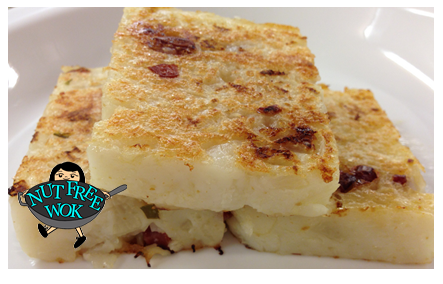
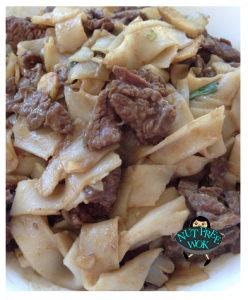

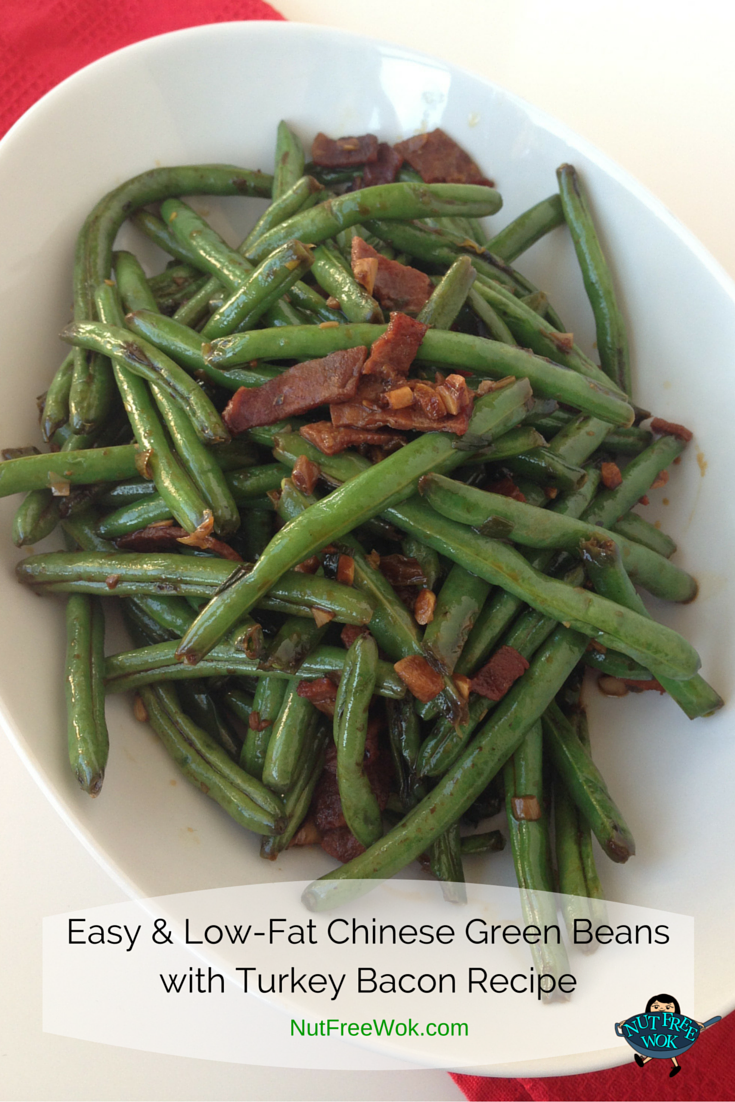
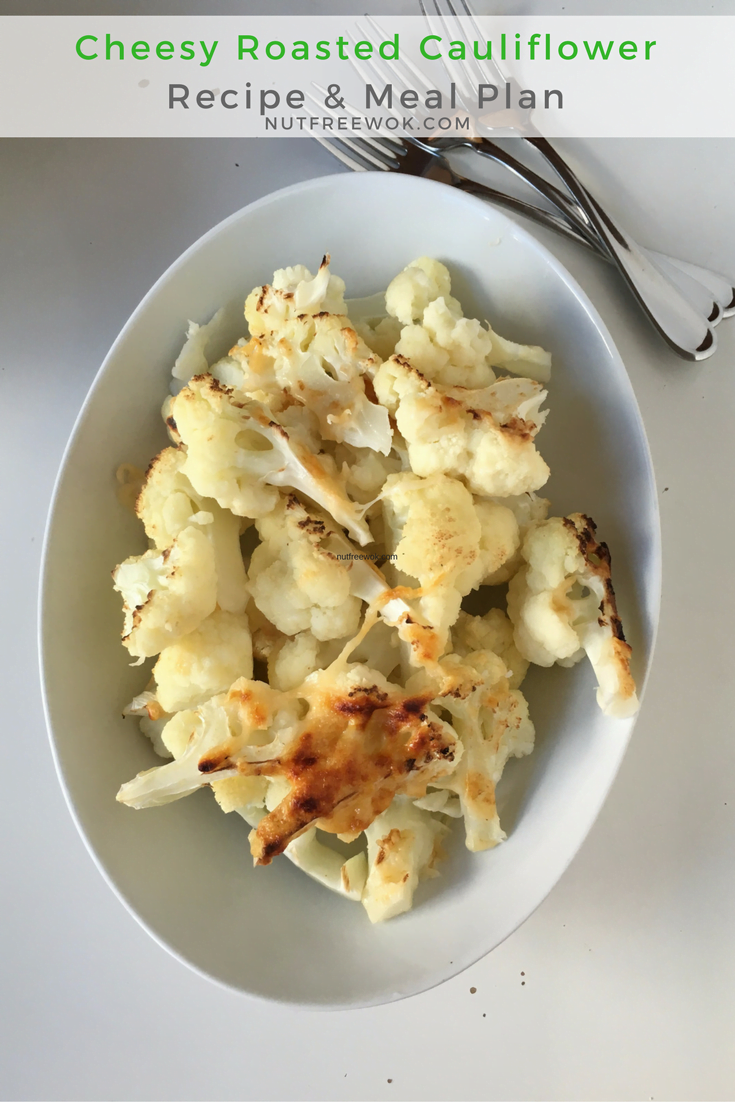

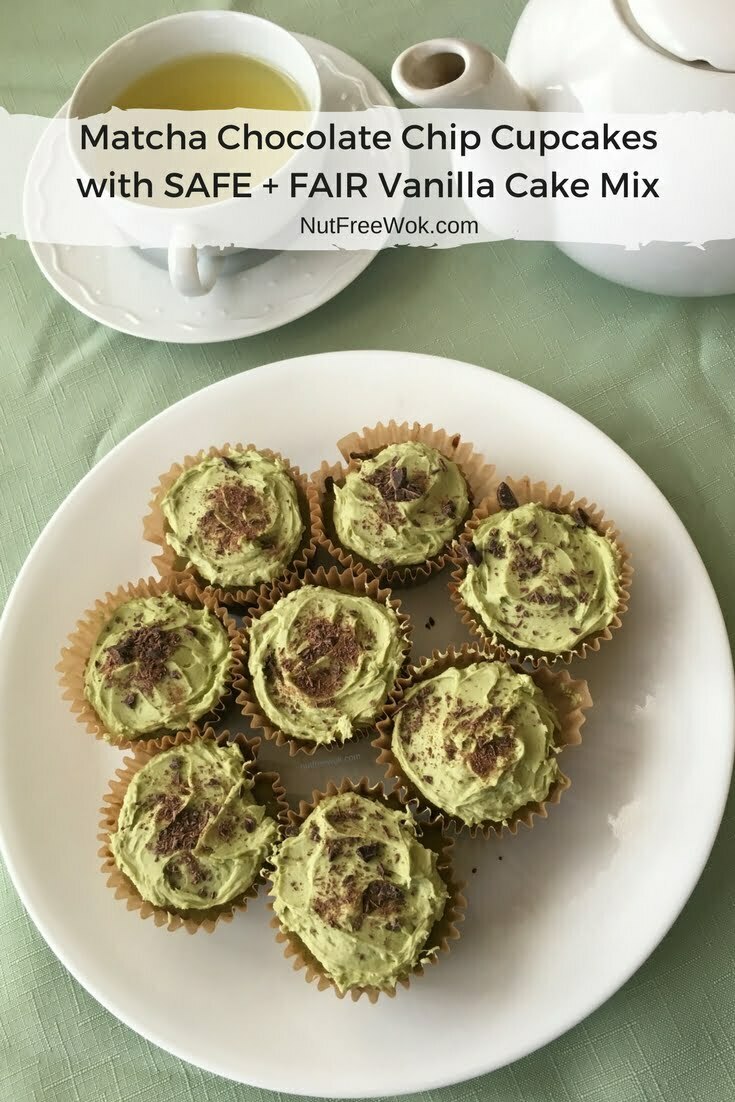
Hi! Thank you for the recipe. I have a problem with steaming. The cake was steamed on a rack inside a pot, with 2″ water and a cloth over the lid but still, a lot of water went into the cake and I’d a pudding :)) What can I do differently? Thanks!
Was the batter thick when you poured it in? The daikon and broth mixture has to be boiling hot when you add the rice flour batter in order for the cake to set properly. I hope that helps.
Just made this for CNY–first time trying to make it from scratch and thought your recipe had the best notes on how to get the flavor right and most detailed instructions. Used a single 2-lb turnip, and simmered it with the cover off because I hadn’t thought to read the comments before I cooked it, but it still came out great–a big hit with the family! Thank you so much–we’ll definitely be keeping this recipe handy and making it again.
Thank you! I’m so glad your family loved the turnip cake and the recipe instructions. <3
We love to try your recipe for turnip cake. However, do you have one for taro cake?
Thanks,
Pat
I know how to make taro cake but unfortunately one of my sons might be allergic to taro and I find that I develop a little bit of contact dermatitis when I handle it (it’s actually common, so wear food safe gloves), so I’m not likely to develop the recipe to share. Generally, you will want to peel, chop, and cook the taro until it’s fork tender. Then you prepare the same kind of filling as turnip cake (chopped chinese sausage, dried shrimp) and rice flour batter. Place your filling and taro in a round cake pan, add your rice flour batter and steam until it’s set.
Dear Sharon,
Please weigh your daikon and post the weight in the recipe. This would help us all to get the proper consistency and facilitate multiplying batches.
P.S. – In my family we sometimes like to add diced Lahp Yook and finely diced precooked Black Mushrooms to turnip cake along with sautéed minced shallot and a dash of white pepper powder:))
Many Thanks!
I went to the market and picked up a few daikon according to the directions I gave (about 1.5 inch in diameter, medium sized) and they all weigh about 1 pound, give or take a few ounces. If you wanted to double the recipe, you can’t use a giant 2 pound daikon and get the same results and taste. My recipe is already a family sized recipe, try it as is before you try to double or quadruple the recipe unless you have a commercial or restaurant kitchen.
How cool! We have a lot of turnips from our CSA and I am always looking for new recipes!
I’ve never tried dim sum before! Your site makes me want to try so many new dishes! Looks delish. Thank you.
Just discovered your recipe. Looks delicious.
I am thinking of trying with brown rice flour. How did yours turn out?
thanks!
Hi Shan, I’ve tried it with brown rice flour, it turns out great but the texture is not traditional! It has a great flavor. One tip about brown rice flour is that it goes bad quickly so just use it up after you buy it or freeze the leftovers. Enjoy!
Made this for my family over the weekend they loved it, had it with a little hoisin sauce. I do have a question, it came out a little more firm than what were use to. Could it have been the rice flour brand? I didn’t use the one you recommended I’m going to try again with the one you like. Other than that any ideas what I should try differently? Tough question I know:) I was sure I followed directions:) a Thanks again:)
Hi Gladys, Good for you for trying, yay! And I’m glad your family enjoyed the daikon cake! It’s hard to guess exactly why it came out a little firm. Erawan rice flour yields the most tender results compared to other rice flours. I also find the texture of the daikon also makes a difference, finely grated daikon seems to form a sturdy composite with the rice flour compared to the chunks just hanging out with steamed rice cake. 😉 I just realized that I didn’t mention to simmer the daikon with a lid on as that could make a difference in the amount of liquid in your batter. Thanks so much for taking the time to leave a comment!